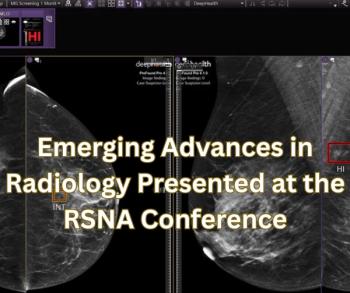
MRI finds hidden intra-abdominal fat in high-risk teens
MRI has proven to be a reliable, fast, noninvasive means for assessing deep fat in adults. Now new research from the Mallinckrodt Institute of Radiology, Washington University School of Medicine, in St. Louis supports MRI’s effectiveness in measuring intra-abdominal fat in pre-adolescents and adolescents.
MRI has proven to be a reliable, fast, noninvasive means for assessing deep fat in adults. Now new research from the Mallinckrodt Institute of Radiology, Washington University School of Medicine, in St. Louis supports MRI's effectiveness in measuring intra-abdominal fat in pre-adolescents and adolescents.
External fat, such as love handles, is easy to identify, but internal fat around the abdominal organs is more difficult to assess and potentially more harmful.
"Metabolic abnormalities appear to be more closely associated with intra-abdominal fat tissue, or deep fat," said lead researcher Dr. Marilyn J. Siegel, a professor of radiology and pediatrics. "If you can more reliably measure the deep fat, you can better assess which patients are more at risk for diabetes, heart disease, and fatty liver."
Published in the March issue of Radiology (242:846-856), the study evaluated 30 young subjects. The group was composed of 20 boys and 10 girls between the ages of 10 and 18. Nine were overweight but nondiabetic, 10 were overweight with type 2 diabetes, and 11 were normal-weight nondiabetic young people.
The patients were imaged using single-section and whole-abdominal multisection MRI. A computer-assisted software program quantified subcutaneous, visceral, and total abdominal adipose tissue (fat) volumes. These results were compared with measurements taken through anthropometry and dual-energy x-ray absorptiometry (DXA), the conventional means for evaluating adipose tissue.
Anthropometric measurements include waist circumference, abdominal height, and body mass index. DXA distinguishes fat tissue from lean mass, but the process requires a time-consuming whole-body scan and subjects the patient to potentially harmful ionizing radiation.
Siegel and her research team found that the single- and multisection T1-weighted MRI measurements of abdominal adipose tissue corresponded with results from anthropometric assessment and DXA. Single-section MRI characterized the body fat as well as the multisection exam.
"Screening examinations have to be short," Siegel said, "and the single-section MRI only took about five minutes."
Siegel expects fast MR imaging to assist in diagnosing overweight children and in developing weight management strategies. Her next step is to study a larger population of youngsters to validate this preliminary research. In recent related research, she demonstrated that ultrasound can be a reliable tool to screen for liver fat in morbidly obese adolescents.
For more information from the Diagnostic Imaging archives:
Newsletter
Stay at the forefront of radiology with the Diagnostic Imaging newsletter, delivering the latest news, clinical insights, and imaging advancements for today’s radiologists.




























